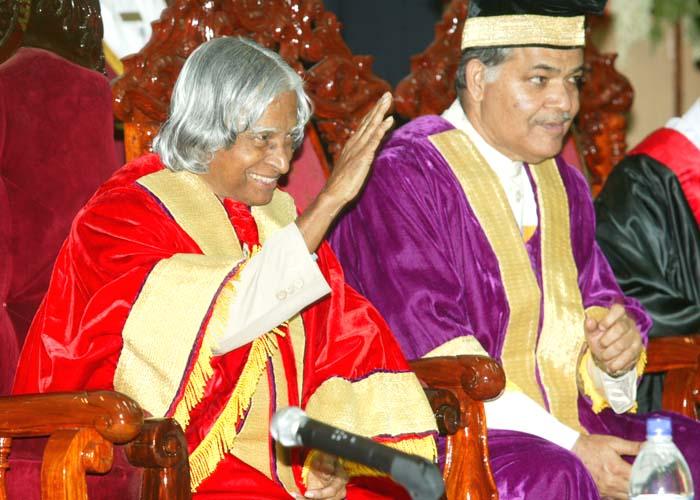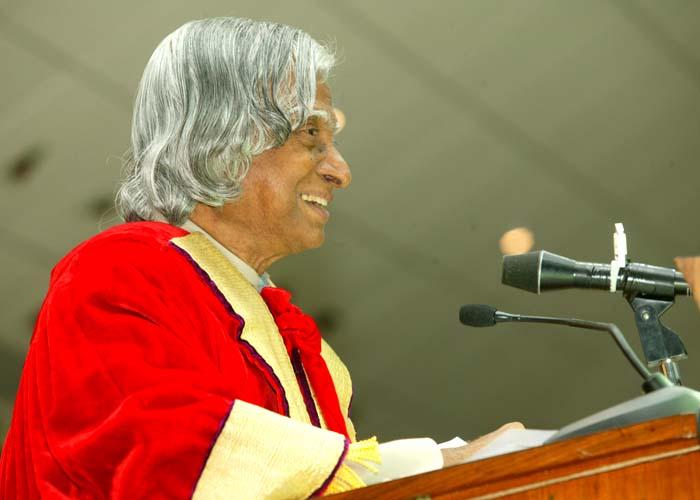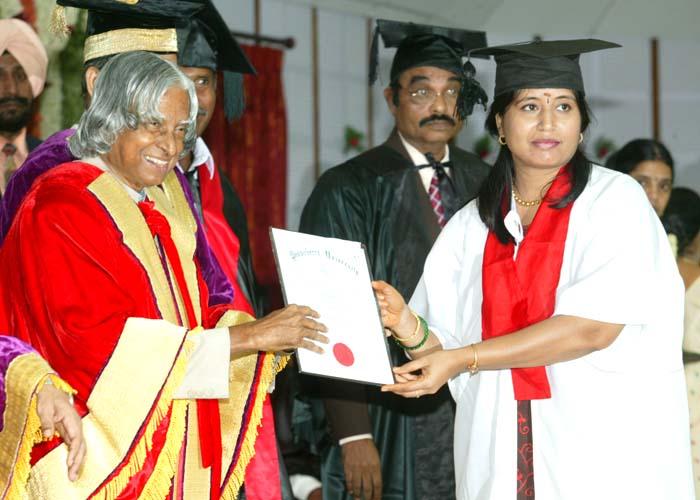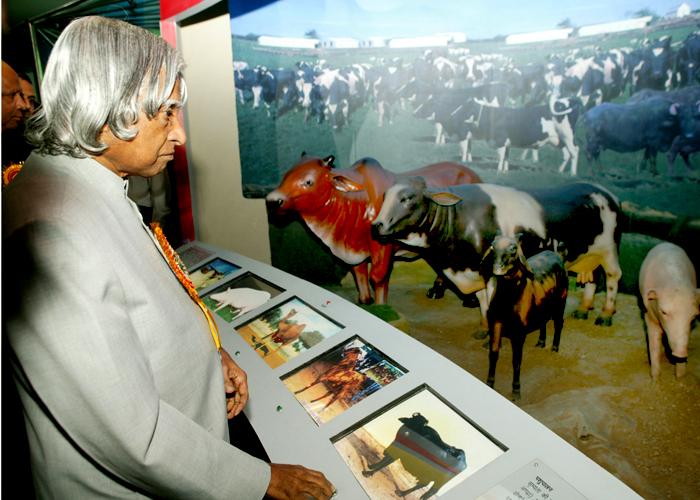Address During The 15th Convocation Of Pondicherry University, Pondicherry
Pondicherry : 01-11-2004
Creative Leaders for National Development
I am indeed delighted to participate in the 15th Convocation of Pondicherry University. I take this opportunity to congratulate the University students for their excellent academic performance. I greet the Chancellor, Vice-Chancellor, Professors, teachers and staff for shaping the young minds and preparing them to contribute to the nation in multiple fields. Dear graduates, when you complete your education in this University, the learning and in turn the empowerment will certainly assist you to meet the challenges in life. My best wishes. On this occasion, I would like to share with you my experience with some of the inspiring leaders who touched my life. These experiences, I am sure will enable some of you to chart your course for contributing towards the transformation of Pondicherry into a prosperous, happy and peaceful state.
Indomitable Spirit and Forgiveness
I met a great personality during my visit abroad in September 2004 who was responsible for the freedom of South Africa. He is none other than Dr. Nelson Mandela. Particularly for the young people, you can learn two big lessons from this personality. They are indomitable spirit and virtue of forgiveness.
Cape Town is famous for its Table Mountain; it has got three peaks called Table Peak, Devil Peak, and Fake Peak. Between the peaks it was a beautiful sight throughout the day, sometimes dark clouds and sometimes white clouds embracing the peaks. Table Mountain is very close to the sea coast of the Atlantic Ocean. We flew by helicopter to Robben Island from Cape Town in 10 minutes. It will take 30 minutes by powered boat to reach the Robben Island. When we reached the Island, except for sea roaring, the whole island was silent symbolizing the thought: this is the place the freedom of individuals was chained. We were received at the Island by Mr. Ahmed Kathrada, a South African, who was a co-prisoner with Dr. Nelson Mandela. What surprised me was Dr. Nelson Mandela was kept in a tiny room where sleeping and all human needs had to be fulfilled. Even the sound of sea waves can not penetrate the prison cell. It has to be remembered that Dr. Nelson Mandela, who was 6 feet tall was imprisoned in that room for 26 years ? fighting against the apartheid. The major part of his life was spent in this silent Island. He used to be taken for quarrying in the nearby mountain for a few hours in bright sun. This is the time his sight got affected. In spite of his body being tortured, he revealed to the world his indomitable spirit. This is the time he evolved a manuscript of freedom movement in tiny letters every day, when the jail wardens went to sleep. This small tiny lettered manuscript finally became the famous book of Mandela ?A long walk to freedom?.
It was a great event for me to meet him in his house in Johannesburg. Dear friends, I would like to share with you, when I entered Dr. Nelson Mandela?s house, I saw his three dimensional form with cheerfulness. Cheerfulness filled the whole atmosphere. This mighty man got the freedom for South Africa in 1994 from the tyranny of apartheid. Dr. Mandela, when he became the President of South Africa, gave those people who practiced apartheid, ill-treated and put him in the jail for 26 years, the freedom to move and freedom to live in South Africa as equal citizens. I felt that I was touching the hand of a Mighty Soul. When he started walking, he used to have a walking stick. He discarded the walking stick and I became his support, his walking stick, a gesture which I liked. Dear friends, a big lesson that we learn from this personality Dr. Nelson Mandela is characterised in one of the Thirukkurals written 2200 years before.

which means: for those who do ill to you, the best response is to return good to them?.?
Great Sons of India
Dear friends, I visited Visva Bharati in early October. Though there are many good houses in Visva Bharati, Gandhiji preferred to stay in Shyamali, which is a mud hut, when he visited Gurudev Rabindranath Tagore for a month. While Mahatma Gandhi was taking leave, Tagore handed over a letter about the Visva Bharati to the Great Mahatma. I would like to read out a few lines from that letter (2 Feb 1940) in order to bring out the care, the visions and the conviction with which both these great sons of India, were bringing up Visva Bharati. I quote Tagore,
?And, now, before you take your leave from Santiniketan, I make my fervent appeal to you, accept this institution under your protection giving it an assurance of permanence if you consider it to be a national asset. Visva-Bharati is like a vessel which is carrying the cargo of my life?s best treasure and I hope it may claim special care from my countrymen for its preservation.?
Friends what we learn from the meeting of two great minds is that they shared the same beautiful vision for an Independent Nation through Visva-Bharati which was Tagore?s ??life?s best treasure??
Self Conscious activity
While at Kolkatta, I was also happy to inaugurate the heritage centre built around the ancestral home of Swami Vivekananda. The heritage centre is a standing monument for the great work of Swami Vivekananda in creating enlightened citizens. Dear friends, I am reminded of a brief exhortation to our people given by Swami Vivekananda.
?Teach yourself. Teach everyone his or her real nature. Call upon the sleeping soul and see how it awakes. Power will come, glory will come, goodness will come, purity will come, and everything that is excellent will come, when this sleeping soul is roused to self conscious activity?.
Swami Vivekananda?s call for self conscious activity, or self awareness, is indeed a call to all of us to be transformed into enlightened citizens. This is true for all of us here particularly since we are all in the land of Sri Aurobindo.
Visionary Leaders
Very rarely, in the life journey, great human beings influence one?s life. I had the privilege of working with three such personalities. Prof. Vikram Sarabhai started his career in the laboratory of Sir C.V. Raman at IISc. I was fortunate to work with Prof. Vikram Sarabhai for seven years. While working closely with him, I saw the dawn of the vision for the space programme in a one page statement. Witnessing the evolution of this one page by many years of ceaseless work by a cosmic ray physicist, a great scientific mind was really a great learning for me.
Also I was thrilled to see the famous vision statement of Prof Vikram Sarabhai made in the year 1970 which states ?India with her mighty scientific knowledge and power house of young, should build her own huge rocket systems (satellite launch vehicles) and also build her own communication, remote sensing and meteorological spacecraft and launch from her own soil to enrich the Indian life in satellite communication, remote sensing and meteorology.?
When I look back at this vision statement now, I am overwhelmed to see the results of this statement. Today, India can build any type of satellite launch vehicle, any type of spacecraft and launch from Indian soil and also it has all the capability with its mighty facilities and powerful human resource. Through space technology and space science, India can make global contribution for the prosperity of our planet.
Creative Leadership
The next message I have for the young and aspiring students in front of me is what I learnt from Prof. Satish Dhawan, a great teacher from IISc and former Chairman of ISRO. I worked with Prof Satish Dhawan for a decade particularly in the development of the first satellite launch vehicle programme for which I was fortunate to have been chosen as the Project Director. When I completed the project Prof. Satish Dhawan gave to the country, particularly the young, a great leadership quality which we cannot find in any management book. He taught me a lot through his personal example. When a mission is progressed, there will always be some problems or failures, but the failures should not become the master of the programme. The leader has to subjugate the problem, defeat the problem and has to lead the team to success. This knowledge is embedded in me right from those days and standing by me throughout my life.
Nobility in thinking
The next teacher, I would like to discuss is Prof Brahm Prakash. When I was the Project Director of SLV3 programme, Prof. Brahm Prakash ? a great scientific leader with nobility, was the Director of Vikram Sarabhai Space Centre (VSSC), which integrated multiple institutions based on the advice of Prof. Kamala Chowdhuri, a management guru from IIM. Prof Brahm Prakash took hundreds of decisions for the growth of space science and technology.
One important decision which I will always cherish was once a programme such as SLV3 is sanctioned the multiple laboratories of Vikram Sarabhai Space Centre and also the multiple centres of ISRO including the Space Department have to work to realize the stated goals of the programme as a team. Particularly during 1973 ? 1980, there was a tremendous financial crunch and competing requirements from many small projects. He integrated all scientific and technological work and focused it towards SLV3 and its satellite programme. When I say that Prof. Brahm Prakash is famous for the evolution of management with nobility, I would like to give a few instances. He enabled for the first time evolution of a comprehensive management plan for SLV-3 programme towards the mission of putting the Rohini satellite in orbit. After my task team prepared the SLV3 management plan, in a period of 3 months time, he arranged nearly fifteen brainstorming meetings of the Space Scientific Committee (SSC). After discussion and approval, this management plan was signed by Prof Brahm Prakash and became the guiding spirit and working document for the whole organization. This was also the beginning of converting the national vision into mission mode programmes. During the evolution of the management plan, I could see, how multiple views emerged and how, many people were afraid of losing individuality due to the main mission, thereby throwing anger in the meetings. I could also see how Prof. Brahm Prakash radiated with smile in the midst of continuous smoke coming from the cigarette continuously being lit one after the other. The anger, fear and prejudice have all disappeared in the presence of his nobility in thinking.
Today, the space programme, launch vehicle, spacecraft, scientific experiments and launch missions all are taking place in the centres of Indian Space Research Organization in a cohesive and cooperative manner. I thank this great soul who evolved the concept of management with nobility and was a very famous professor in metallurgy at the Indian Institute of Science. He was also a pioneer for giving the country ? nuclear material by establishing the Nuclear Fuel Complex (NFC).
Dear students, you have seen how our nation has created great souls with self-awareness, vision, nobility, creative leadership with indomitable spirit, I am sure, this great educational institution will enable you to imbibe all these qualities of the great sons of India.
University Core Competence
The Core competence of the Pondicherry University is mainly in management studies, computer science, earth science, chemistry, international studies, French, English and Tamil literatures. I also understand the Centre for Ocean and Island Studies at Andaman & Niocbar is offering M.Sc. marine biology course for the benefit of islanders. Apart from twenty thousand students on the rolls of the colleges affiliated to the University you have a distance education programme with strength of twenty two thousand students.
Academic Support Human Resource Development for Missions
The Core competence of the University should be utilized for generating quality human resource for the execution of mission mode projects by Pondicherry. Some of the mission mode project include PURA, wasteland development, intensive commercial agriculture, integrated water resource management, renewable energy, ICT, tourism, fisheries and aqua-culture and value added garment industry. The University should play a major role in support of these economic development missions. Almost every School and Department in the University has the capability to assist the mission authorities in detailed systems studies, mathematical modeling and system analysis and Feasibility Studies. For example, the School and Environmental Studies and many other Departments can participate effectively in the Integrated Water Resources management Programme. Wherever the core strength is yet to be built up in the University, they can seek the assistance from other academic and research institutions. For example, for the Wasteland Development Mission, the University can have collaboration with ICRISAT for Jatropa plantations. The University can also, in partnership with banking systems and the government / non-governmental organizations, create from the pool of students a large number of entrepreneurs who can contribute in the execution of mission mode projects for the development of Pondicherry. The Centre for Entrepreneurship Training and Development can play a key role in this mission area.
Literacy mission
Pondicherry University can participate in a mission with the prime responsibility for education, research and creation of enlightened citizens in this region. The Centre for Adult and Continuing Education can play an important and coordinating role for this mission. You should look beyond the campus and see what opportunities we have to assist the society. One of the possible schemes, you can undertake is a literacy mission to the nearby rural areas. You have nearly 40 colleges in this University with a student?s strength of 20,000. In addition you have over 22,000 students participating in the distance education programme. This is a big resource for contributing in the literacy programme of the four regions (Mahe, Yanam, Karaikal & Pondicherry) where at present 1.8 lakh persons need literacy. If each student in the University with the guidance of the professors can undertake to educate at least 2 adults per year who cannot read and write the total number of people who can be educated per year will be 84000. In a two year period you can definitely educate more than one and a half lakhs adults. This can be done in addition to the present adult literacy programme. The combined effect will lead to the realization of 100% literacy in Pondicherry within the next two years.
Conclusion: Creative Leadership
Perhaps there has to be one question dominating the minds of faculty and students of this great University. This question is: What can I do as a faculty member or student of the university for the prosperity and growth of Pondicherry and thereby of the nation. There are 540 million youth below 25 years in the population of a billion people. The nation needs young leaders who can command the change for transformation of India into a developed nation embedded with knowledge society. The leaders are the creators of new organizations of excellence. Quality leaders are like magnets that will attract the best of persons to build the team for the organization and give inspiring leadership even during failures of missions as they are not afraid of risks. This is true, because, I have personally seen and worked with creators of visions and missions.
One of the very important ingredients for success of the vision of transforming India into a developed nation by 2020 is the evolution of creative leaders. I am giving a connectivity between developed India, economic prosperity, technology, production, productivity, employee role and management quality, all of which linked to the creative leader. Who is that creative leader? What are the qualities of a creative leader? The creative leadership, is exercising the task to change the traditional role from commander to coach, manager to mentor, from director to delegator and from one who demands respect to one who facilitates self respect. The higher the proportion of creative leaders in Pondicherry, the higher the potential of success of visions like ?developed Pondicherry.? This will synergize the efforts towards the Developed India.
Mission of Pondicherry University is to build capability of creative leadership among students which will generate many young entrepreneurs for participating in the transformation of India into a prosperous, happy and strong nation. I wish all the graduates a very bright future.
May God bless you.




